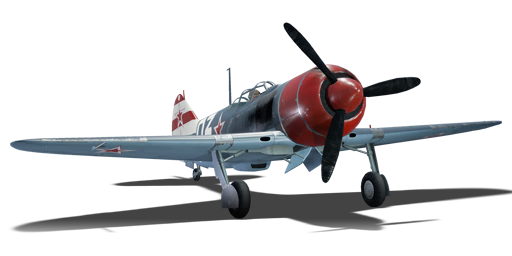


Dolgushin's La-7 was a Soviet fighter aircraft, belonging to Sergei Fjodorovich Dolgushin, a Soviet WWII fighter ace with 15 victories solo and another 8 shared, and also a recipient of Hero of the Soviet Union award. Dolgushin was born on 25 September 1920 in Novopokrovskoje, Tulsa Oblast and joined the Red Army in 1937 to study on Kachin Military Aviation Pilot School where he graduated in 1940 in the same course as Vasily Stalin, Joseph Stalin's youngest son. Dolgushin scored his first two kills on 22 June 1941 when two German planes violated the Soviet border. In May 1942, he was awarded Hero of the Soviet Union for exemplary performance of combat missions of the command on the front of the fight against the German invaders and the courage and heroism shown at the same time. In January 1943, Dolgushin was appointed squadron commander of the 32th GIAP while the regiment was commanded by Vasily Stalin. In September 1943, Dolgushin was appointed commander of the 156th IAP which he commanded until the fall of 1946. He continued to serve in the army until leaving in 1979. Dolgushin died on 29 June 2011 in Moscow.
Dolgushin's La-7 was introduced as a premium pack in Update 1.49 "Weapons of Victory". It was discontinued after the 2017 Victory Day sales and has since been made available briefly for purchase in the store on occasion, such as the 2017 "Special Discounts!", the 2019 Victory Day and the 2021 May sales. The plane is painted after the camouflage scheme of Soviet pilot Sergei F. Dolgushin in the 156th fighter aviation regiment from September 1944 onward. The playstyle and flight performance of the Dolgushin's La-7 are essentially the same as its tech tree counterpart.
flaps
flaps
flaps
brake
| Belt | Belt filling | Armor penetration (mm) at a distance: | |||||
|---|---|---|---|---|---|---|---|
| 10 m | 100 m | 500 m | 1000 m | 1500 m | 2000 m | ||
| FI-T/AP-I | 28 | 24 | 14 | 7 | 4 | 2 | |
| FI-T/HEF/AP-I/FI-T | 28 | 24 | 14 | 7 | 4 | 2 | |
| HEF/FI-T/AP-I | 28 | 24 | 14 | 7 | 4 | 2 | |
| FI-T | 3 | 3 | 3 | 3 | 3 | 3 | |
| AP-I/FI-T/AP-I/AP-I | 28 | 24 | 14 | 7 | 4 | 2 | |
| AP-I/HEF/HEF/FI | 28 | 24 | 14 | 7 | 4 | 2 | |







 2 x (80 / 220 / 405) %
2 x (80 / 220 / 405) % 
 2 x 160 %
2 x 160 % 

Flight performance | |
|---|---|
Survivability |
|---|
Weaponry |
|---|